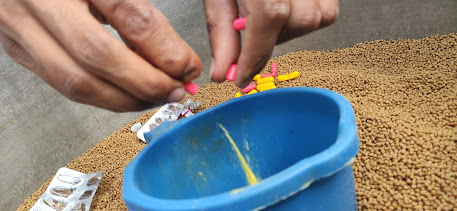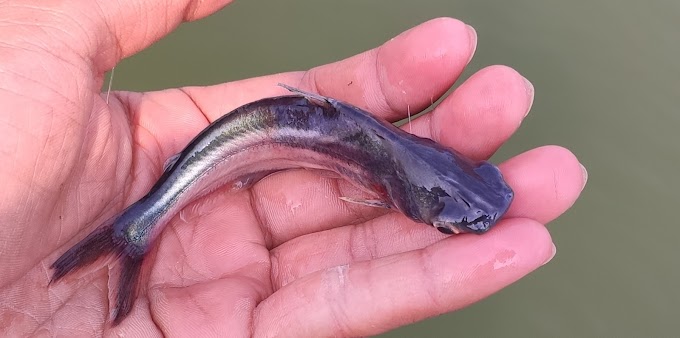UNDERSTANDING FISH NUTRITION and FEEDS
Machali Wale Bhaiyon, You people are welcome on this blog, so today we will talk about the feed of fishes, that is, what is the composition in the Branding Pellets( Abis, CP, Growell or any Commercial feeds).
Table of Contents:
FEED COMPOSITION:
Now let's talk about which substances are included in the feed composition such as proteins, fats, carbohydrates, vitamins and minerals. By combining all these, the feed of the fish is formed, the correct ratio of all these in the feed determines the right percentage that how our feed is, there is a good ratio of all these, so we can say that what we are giving bag feed to our fish is good. As a result of this, we can see that there is good growth in the fishes, they are getting good production.They are not having any issue related to health and there are many benefits of choose feed according to good nutrition value. Supplement diets do not contain a full components of vitamins or minerals but are typically used to help fortify the naturally available diet with extra protein, carbohydrates, and/or fats.
 |
| Tank Fish Kasta; Medicated feed |
PROTEIN:
It is a very important factor and most expensive components of fish feed for our fishes, eating them leads to the development of good muscles in the fish. The muscle increases the weight of our fish. Here, if the percentage of protein becomes less, then it is harmful for our fish. And our fish development slows down and they start showing symptoms related to disease. If we talk about the increment in the percentage of protein, then growth increases in them, if more growth increases, then the body will become longer, they will become weak, due to which many symptoms start showing in the fish, Their eyes start getting damaged. Their body becomes light, the eyes swell and the body that is there becomes crooked, so it is necessary to have the right protein in the FEED of fish.
FAT:
Fat(Lipids) is also very important for our fish, it increases the weight of the fish and the fish we have are metabolically active, they have a proper growth and this keeps the fish energetic, in a way we can say that the site is It works to give a lot of energy to the fish, so proper composition is very important in the field. If it is reduced, then our fish become lethargic and they lack energy, due to which they do not eat proper feed, their metabolism is disturbed. due to which they are at increased risk of disease. If the percentage of the fish is more then our fish become very young. They have rapid growth, due to which their body, which is of streamline, starts getting crooked, it becomes improper, so these are all the reasons due to which the percentage of feed matters a lot in our feed.
CARBOHYDRATES:
Carbohydrate(starches and sugars) is a Carbon compound that are the least expensive sources of energy to our fishes diet. Carbohydrates are included in aquaculture diets to scale back the feed cost and also for his or her binding activity during feed manufacturing. Dietary starches are useful in the extrusion manufacturing of floating feeds. Cooking starch during the extrusion process makes it more biologically available for fishes.
When these feeds are eaten by fishes then its take time to digest in fish body. Afterwords fishes required more oxygen (O2 level) for their digestion. In digestion, less O2 level then in fishes, mortality takes place in our fish farming culture. We have to take care of our fishes when feeding evening or morning. In fishes, carbohydrates are stored in fishes as glycogen that can be mobilized to satisfy energy demands. These Carbon compound are a major source of mammals but not used efficiently by fishes.
For example, mammals can extract energy about 4 calories from 1 gram of carbohydrate, where as fishes can extracts only 1.6 calories from same amount of carbohydrates. Fishes can use up to about 20% of dietary carbohydrates. That's why, Protein and Fats are most valuable compound in fish diets.
VITAMINS:
Vitamins(vital+amines) are organic elements that are must in fish diets to support normal fish growth and health. These compounds are not synthesized by fish but must be provided in the diet. Vitamins are of two types on the basis of solubility and these are:
- Water-Soluble Vitamins and
- Fat-Soluble Vitamins.
Water-soluble vitamins are all B vitamin ( thiamine, riboflavin, niacin, pantothenic acid, pyridoxine, biotin, folic acid, and cobalamins), inositol, choline, and vitamin C ( ascorbic acid). In these, vitamin C is the most important because it is a powerful antioxidants and it also enhances the immunity(immune system) in the fishes.
Fat-soluble vitamins includes vitamins A(retinol, beta carotene), vitamin D (cholecalciferol), vitamins E, and vitamin K. In these vitamins, Vitamin E is most important because it also a powerful antioxidants.
As a feed ingredient, vitamins C and E also inhibit dietary lipids oxidation, thus helping to improve shelf life. Deficiency of any vitamins has its specific symptoms, but reduced growth is the most common symptoms of any deficiency vitamins. Scoliosis (bent backbone symptoms) and dark coloration may result from deficiencies of ascorbic acid and folic acid, respectively.
MINERALS:
Minerals are inorganic elements must available in the diet of fishes for their proper functioning and for proper balancing. These compounds are not synthesized by fish but must be provided in the diet. But fishes can absorb many minerals directly from water through their gills and skin, allowing them to compensate to some extent for minerals deficiencies in their diet. Minerals are of two types on the basis of their requirements and these are:
- Macro-Minerals and
- Micro-minerals
Macro-minerals are Calcium, Sodium, Chloride, Potassium, Chlorine, Sulphur, Phosphorus and Magnesium. These minerals regulate osmotic balance and aid in bone formation, and integrity.
Micro-minerals are Iron, Copper, Chromium, Iodine, Manganese, Zinc, and Selenium. These Traces are required in small amounts as components in enzyme and hormone systems.
CONCLUSION:
Dietary nutrients are essential for the construction of livings tissues. They are a sources of stored energy for fishes digestion, absorption, growth, reproduction, and other life processes. The nutritional value of a dietary ingredient is in part dependent on ts ability to supply energy. Physiological fuel values are used to calculate and balance available energy values in prepared diets.










If you have any doubts/queries about fish farming. Please let me know